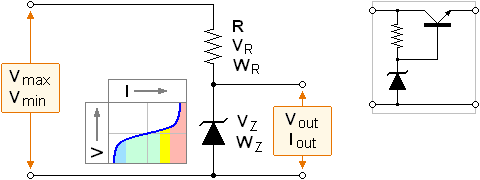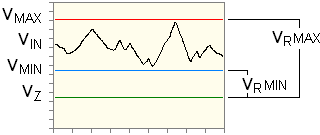
Voltage regulator with zener diode parallel to the load are generally used when is necessary to obtain a reduced voltage of moderate power from the main supply line.
Since it is an analog regulation it has the property to give a stable voltage, without parasitic fluctuation and with limited noise levels. The very low energetic efficiency makes it useful mainly when small current are required.
Max supply voltage . . . VMAX
V
Min supply voltage . . . VMIN
V
Stabilized voltage required . . . VZ
V
Maximum required current . . . IOUT

Dropping resistance . . . R
Ohm
Maximum power dissipated by resistor . . . WR
W
Maximum power dissipated by zener . . . WZ
W
Maximum voltage drop . . . VR MAX
V
Minimum voltage drop . . . VR MIN
V
Max power dissipated by resistor WR.
It refers to the condition in which supply voltage is at the maximum value
(VMAX), the magnitude of the load is indifferent.
Max power dissipated by zener diode WZ.
It refers to the condition in which fails the load and the supply voltage is at
the maximum value (VMAX).
Power of the zener.
The zener diode to be installed should be selected with a power at least equal to
WZ.
Zener temperature coefficient.
As temperature increases, at same current flowing through the zener, the zener voltage
increases if VZ > 5V and it decreases if VZ < 5V.
So the temperature coefficient can, be negative or positive.
A diode with a VZ near 5V has a reduced temperature coefficient.